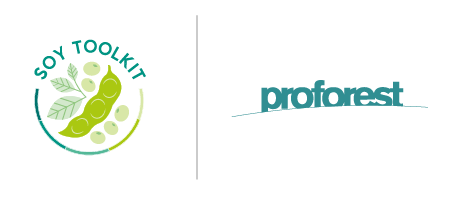Element 3: Engaging within and beyond supply chains
Engaging within and beyond supply chains is a crucial way for buyers to implement their responsible sourcing commitments, and to address complex issues which can’t be addressed within individual supply chains. Through collaboration amongst multiple stakeholders, companies can deliver on commitments at scale without displacing issues elsewhere. This also helps build local engagement and ownership, increasing the likelihood of local positive impact and long-term sustainable development. Actions within the supply chain relate to volumes directly purchased by a company as well as the performance of its suppliers. Actions beyond the supply chain relate to actions that can be taken upstream, at landscape or jurisdictional level, as well as those that can be taken at a sectoral level to address systemic issues and drive long-term transformational change.
The aim of this element is:
· to provide companies with resources to engage and improve suppliers’ programmes.
· to work collaboratively on complex issues through at-scale initiatives beyond company’s individual supply chains
Engaging suppliers
While there is no pre-defined system for supplier engagement, companies can use a framework of good practices, such as:
Awareness raising and training: providing workshops, materials and webinars for suppliers;
Establishing purchase control systems: setting up procedures or systems to cross-check every single soybean purchase against a set of criteria, to be implemented by upstream soybean buyers;
Encouraging suppliers to join continuous improvement programmes.
1. at what level to engage? direct vs indirect
Upstream companies usually buy directly from soy producers or intermediaries and therefore have more leverage on the ground to engage at the level of soy production. Companies downstream are usually further removed from production, and it may be more appropriate to push requirements up their supply chain and support their soybean suppliers’ direct engagement programmes.
2. Prioritise interventions
Decide which suppliers and producing areas will be prioritised.
Upstream companies should determine engagement based on the level of risk of the producer’s or the intermediary’s supply base (see briefing note 2B), the amount of leverage it has over producers and the presence of existing initiatives in the area.
Downstream companies can best translate and transfer their responsible sourcing requirements to their tier 1 soybean suppliers, where they have leverage, since there is no direct relationship and thus no leverage with producers.
3. Understand current practices and gaps
Visits to producers are important to understand current practices and gaps. These can be supplemented or substituted by other methods where appropriate, for example questionnaires, desk-based research, talking to buyers and other stakeholders (e.g. cooperatives), and engaging with other initiatives working in the area.
4. Take action
Up until this point the company is implementing its commitment, but from this point on suppliers are the ones that will spearhead the process by developing a plan and agreeing on the required support, considering initiatives already mapped in a region or in the sector.
Examples of companies at the different stages of the soy supply chain
Key points
The ways in which companies can engage with their suppliers will depend on a variety of factors, including: the company’s position in the soy supply chain, the suppliers’ social and environmental performance, the amount of leverage the buying company has over its suppliers, and what existing initiatives are present in the production area.
To achieve real change on the ground, soy buying companies should ensure there is adequate practical support for producers and that there are clear benefits in meeting buyers’ responsible sourcing commitments (e.g. longer-term contracts, access to finance, support for certification).
Supplier engagement on its own is hardly ever sufficient for changing soy production practices and promoting environmental and social sustainability. It should be combined with other activities such as collaborating in various sector and/or landscape initiatives, and working towards certification.
Learn more in Briefing note 3A: Engaging soy suppliers.
Working at scale to implement soy sourcing policies
At-scale initiatives are emerging as means to help companies address the underlying causes of many complex issues, including deforestation and human rights issues. They can be linked with companies’ policy implementation efforts and build on multiple stakeholders’ actions in a given geography.
1. Identify and analyse the existing initiatives
After selecting a landscape in which to act and deciding that a landscape initiative can help address the key issues in the region, it is important to assess what is already happening on the ground: develop an understanding of the local context, identify the relevant stakeholders and map existing initiatives. Once you have assessed existing initiatives you need to decide which ones help deliver your company’s commitments.
2. Define how to engage and how to support the initiative
Understand the local perspectives, motivations and decision-making, since they may differ considerably from the company’s perspective. To understand the local context, companies can:
Research secondary information on online platforms;
Connect and dialogue with a local partner;
Map the stakeholders involved and connect with key actors;
Understand existing governance, decision-making processes and power relations;
Identify issues that matter to local stakeholders;
Clarify what support the initiative needs from external sources and what support it might already have.
3. Agree on your role and take action
Agree clearly what the company’s role should be, based on the needs and objectives of all parties, what the limits to that role are and who they will work with. This step must combine the local perspectives and motivations, as well as the types of support the company or companies can bring.
4. Monitor and report progresS
Agree and implement a credible approach to monitoring of the process, of progress in delivering goals and on the use of funds, with a well-defined monitoring and evaluation (M&E) framework with relevant indicators to track progress and well-established processes to collect and share data. In addition, the company may also need its own review of the effectiveness of engagement with the landscape initiative.
Key Points
The purpose of at-scale initiatives is to work collaboratively on complex issues beyond individual supply chains at the appropriate scale of intervention.
After selecting a landscape to act in, companies should identify and analyse existing initiatives in order to decide which ones help deliver on the company’s commitments and how to engage with them.
The next step is to agree on the company’s role and clarify how to take action, monitor & report progress.










